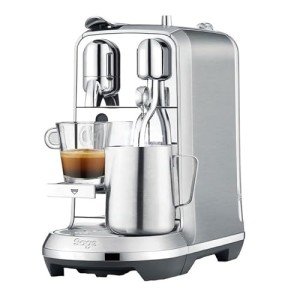15 Things You Didn't Know About Stainless Steel Espresso Machines
The Art of Italian Espresso Machines: A Brewed Tradition
Italian espresso machines are not just home appliances; they are an essential part of Italy's rich coffee culture, representing a blend of artistry, engineering, and style. Buy Espresso Coffee Machines around the globe recognize the importance of high-quality espresso, a staple of Italian life and cuisine. This article checks out the history, mechanics, types, and elements to consider when buying an Italian espresso machine, showing the depth of this beloved drink and its brewing methods.
History of Espresso Machines
The espresso machine's evolution go back to the early 20th century in Italy, where coffee was not simply a drink however a necessary social ritual. The preliminary attempts to brew espresso begun with easy, stove-top models, slowly developing into intricate machines that could replicate the perfect brew.
- 1901— The First Espresso Machine: The very first steam-powered espresso machine, referred to as the “Ideale,” was developed by Luigi Bezzera. This machinery marked a turning point in espresso developing.
- 1938— The Lever Machine: The intro of the lever machine made it simpler to manage the pressure utilized in espresso extraction, improving taste consistency.
- 1947— The Automatic Machine: Reaching more customers, Gaggia released the very first automatic espresso machine, additional promoting espresso bars.
- 2007— The Digital Age: Technological advancements resulted in the birth of totally programmable machines, allowing users to tailor their brewing settings to achieve an individualized coffee experience.
Secret Features of Italian Espresso Machines
Italian espresso machines embody precision, workmanship, and innovation. Here are some crucial components that highlight their significance:
Feature
Description
Boiler Type
Figures out how heat is produced and kept. Common types include single boiler, dual boiler, and heat exchanger.
Group Heads
Where the coffee is brewed; commercial machines often have several group heads for efficiency.
Pressure Control
Crucial for accomplishing the ideal espresso; most machines run at 9 bars of pressure.
Frothing Capabilities
The steam wand allows for milk frothing, necessary for beverages like cappuccino and latte.
Develop Quality
The materials used (stainless-steel, brass, and so on) influence durability and heat retention.
Types of Italian Espresso Machines
Picking the best machine hinges on user preferences, budget, and meant use. Below are the main kinds of Italian espresso machines:
Manual Espresso Machines
- Pros: Offer full control over the brewing procedure, permitting a customized touch.
- Cons: Require skill and practice, can be labor-intensive.
Semi-Automatic Machines
- Pros: Provide a balance in between automated and manual procedures; users control water flow.
- Cons: Can have a steeper knowing curve than totally automatic machines.
Fully Automatic Machines
- Pros: Simplify the brewing procedure with push-button operations; suitable for newbies.
- Cons: May sacrifice some of the subtleties of manual developing.
Super-Automatic Machines
- Pros: Grind, tamp, brew, and froth immediately; convenient for busy lifestyles.
- Cons: Less control over the developing variables, capacity for a less authentic espresso experience.
Purchasing Guide: Factors to Consider
Choosing the perfect Italian espresso machine can be overwhelming, however thinking about the following aspects can simplify the decision-making procedure:
- Budget: Italian espresso machines vary from affordable to high-end models, so set a budget upfront.
- Usage Frequency: Evaluate how frequently you will use the machine; daily users might want a more durable alternative.
- Space: Measure your cooking area or counter space; some machines can be big and require adequate clearance.
- Maintenance: Consider ease of cleansing; machines with removable parts or built-in cleaning features may decrease maintenance.
- User Skill Level: Beginners may choose fully or semi-automatic machines, while skilled baristas can handle manual machines.
- Brand name Reputation: Research brand names known for quality, such as Breville, Gaggia, and La Marzocco.
Popular Italian Espresso Machine Brands
Italian workmanship is renowned for producing some of the best espresso machines worldwide. Here are top brands worth considering:
- Gaggia: Known for its home espresso machines and cost.
- La Marzocco: A superior brand name known for its commercial-grade machines and innovative technology.
- Rancilio: Renowned for its resilient build and professional-quality machines ideal for home and commercial use.
- Sage/Breville: Offers advanced functions and easy to use styles, best for both novices and lovers.
Frequently asked questions
What is the difference in between espresso and regular coffee?
Espresso is a focused coffee brewed by forcing warm water through finely-ground coffee under pressure. It has a thicker consistency, richer flavor, and greater caffeine concentration than routine coffee.
Can I make milk-based beverages with an espresso machine?
Yes, lots of Italian espresso machines include a steam wand to froth milk for drinks like coffees, lattes, and macchiatos.
How typically should I clean my espresso machine?
Regular maintenance is important. Typically, a comprehensive cleaning is advised every couple of weeks, while descaling needs to be done every 1 to 3 months, depending upon water firmness.
What is the ideal pressure for developing espresso?
The ideal pressure for developing espresso is around 9 bars. This pressure guarantees the ideal extraction of tastes from the coffee premises.
Are more costly machines worth the investment?
Higher-end machines frequently use much better materials and innovation, supplying enhanced toughness and more constant outcomes. For major coffee enthusiasts, purchasing a good machine can elevate the espresso experience significantly.
Italian espresso machines are a lot more than simple brewing gadgets; they are a celebration of a cultural tradition that has influenced coffee consumption worldwide. With numerous designs offered to fit any user's requirements— ranging from novices to seasoned baristas— there is an Italian espresso machine perfectly fit for everybody. As you start your espresso journey, understanding the history, mechanics, and options will enrich your experience and appreciation for this time-honored drink. Whether you seek to recreate a café ambiance in your home or fine-tune your brewing method, these machines are capable of delivering unforgettable cups of espresso embellished with the rich history of Italian coffee culture.
